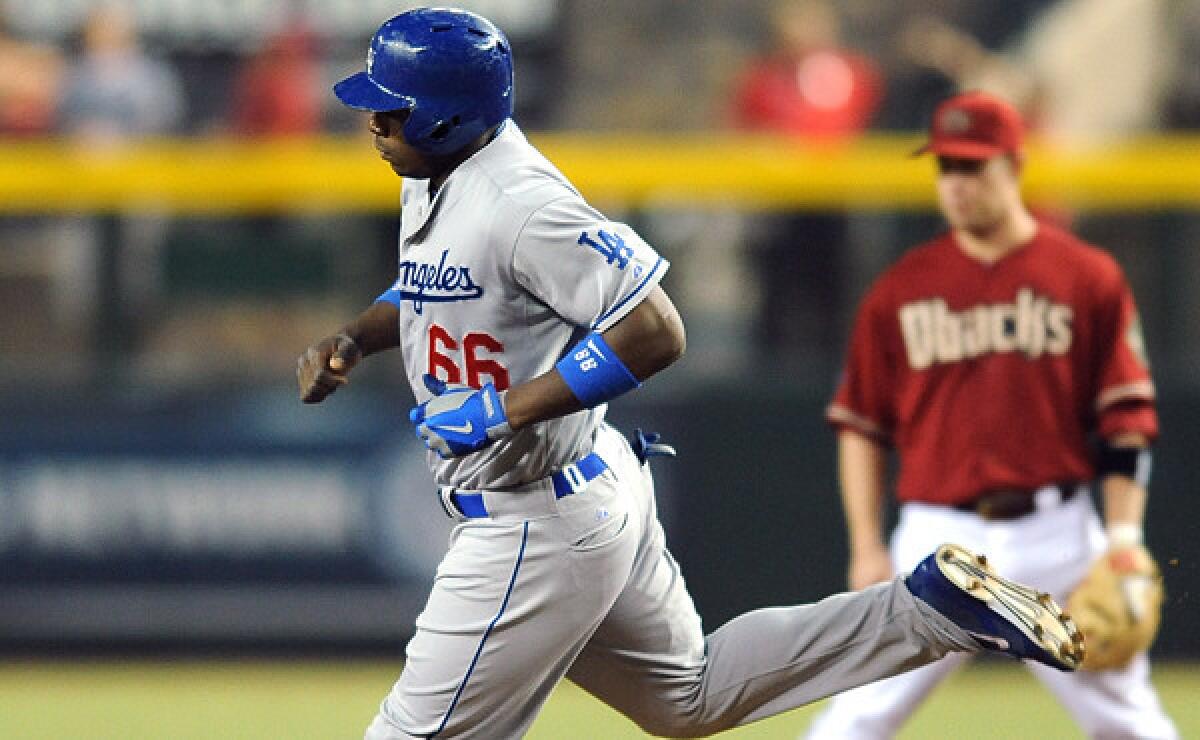Dodgers and Diamondbacks to test each other as Cactus League opens

- Share via
As the Cactus League opens for play Wednesday, the most immediate story line is not difficult to determine: Is there really a rivalry between the Dodgers and the Arizona Diamondbacks?
The Dodgers won the National League West. The Diamondbacks complained when the Dodgers jumped into the Chase Field pool to celebrate the division title, then mocked them for sending A.J. Ellis to Australia to promote the season opener rather than, say, Clayton Kershaw.
The Dodgers and Diamondbacks face each other Wednesday and Thursday, then once more in Arizona, then twice in Sydney, in the opening series down under. SportsNet LA, the Dodgers’ new television channel, plans to fill the hours before the season opener with replays of two games between the teams last season — the one in which the Dodgers jumped into the Arizona pool, and the one with the bench-clearing brawl.
After the teams return to the United States, they play each other on consecutive weekends in April — first in Phoenix, then at Dodger Stadium.
By then, the local focus ought to shift to the Dodgers’ chances to make the World Series for the first time since 1988, and the Angels’ chances to make the playoffs for the first time since 2009.
Here are five story lines from the Cactus League, focusing on the teams that could stand between the Dodgers and Angels and their goals:
Even money
Can the San Francisco Giants win the World Series in 2010, 2012 and 2014?
If that trend of even years is to continue, it will be because of the starting pitching, and the only change in the rotation between last season and this is Tim Hudson for Barry Zito.
Madison Bumgarner has emerged as elite, but the Giants need the Matt Cain and Ryan Vogelsong of 2012, not 2013.
Cain’s earned-run average jumped from 2.79 to 4.00 — albeit 2.36 after the All-Star break — and Vogelsong’s from 3.37 to 5.73. Tim Lincecum, now a supporting arm, ranked third in strikeouts in the NL West last year, behind Kershaw and Bumgarner.
For starters
In 2011, the last time the Texas Rangers won the American League West, four pitchers started at least 30 games. In 2012, one did. In 2013, two did.
Derek Holland started 33 games last season, but he is expected to sit out the first half of this one because of a knee injury. The other seven experienced starters — Yu Darvish, Matt Harrison, Alexi Ogando, Martin Perez, Colby Lewis, Nick Tepesch and ex-Angel Tommy Hanson — all spent time on the disabled list last season. Harrison already has had neck and back stiffness this spring.
Power drought
In third baseman Chase Headley and outfielder Carlos Quentin, the San Diego Padres could have two 30-home run bats in their lineup — if, that is, the two could be healthy and productive at the same time.
Headley hit 31 home runs two years ago but hit 13 last year. Quentin averaged 27 home runs in four years with the Chicago White Sox, but he has hit 16 and 13 in two years with the Padres, playing barely more than half the games.
Headley already is injured this spring; he is expected to sit out two to three weeks because of a strained calf.
Powering up?
In 2012, Arizona finished fourth in the NL in runs and sixth in home runs. But the Diamondbacks thought they were too dependent on home runs, so they traded Justin Upton and Chris Young.
In 2013, they finished fifth in runs, 11th in home runs. So back to power they went, their major off-season move the acquisition of Mark Trumbo from the Angels.
Trumbo and NL most-valuable-player runner-up Paul Goldschmidt combined for 70 home runs last season; Yasiel Puig, Hanley Ramirez and Adrian Gonzalez combined for 61 for the Dodgers.
End of an era
The Oakland Athletics set up camp at Phoenix Municipal Stadium, the last of the utilitarian training sites.
Phoenix Municipal harks back to a time when teams treated spring training as a break-even proposition, not a vehicle to sell $50 tickets to watch maybe half the stars play half the game.
In 1964, Willie Mays hit the first spring home run at Phoenix Municipal; some of the light towers there once stood at New York’s Polo Grounds.
This is the last major league camp at Phoenix Municipal. The A’s move to Mesa next year.
Twitter: @BillShaikin
More to Read
Are you a true-blue fan?
Get our Dodgers Dugout newsletter for insights, news and much more.
You may occasionally receive promotional content from the Los Angeles Times.








